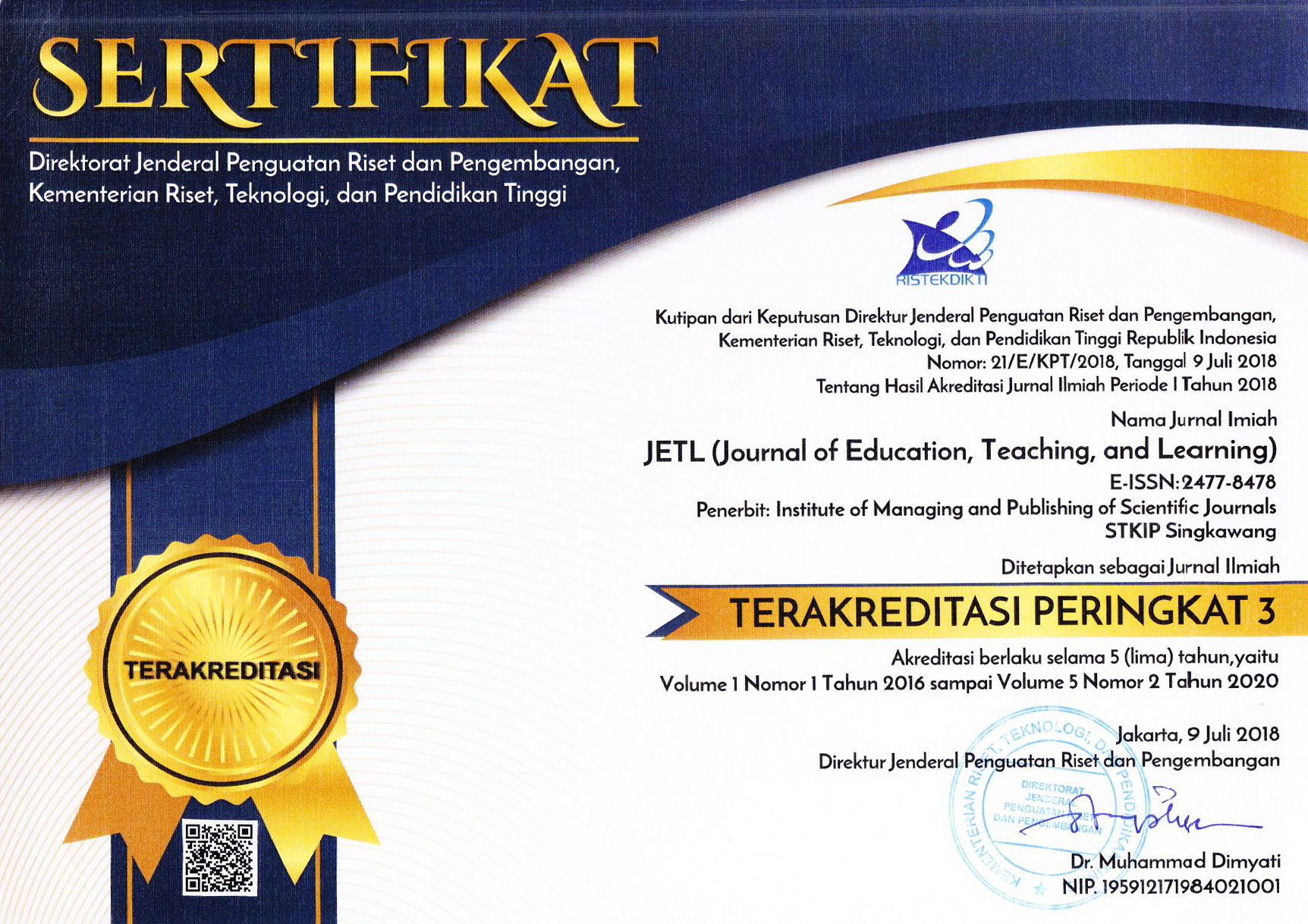Learning Speaking Using Flash Cardboard: English as a Foreign Language Students’ Perception
Abstract
Keywords
Full Text:
PDFReferences
Allam, M., & Elyas, T. (2016). Perceptions of Using Social Media as an ELT Tool among EFL Teachers in the Saudi Context. English Language Teaching, 9(7), 1. https://doi.org/10.5539/elt.v9n7p1
Bruner, J. S., & Austin, G. A. (1986). A study of thinking. Transaction publishers.
Chee, T.S., and Wong, A.F.L. (2003). Teaching and learning with technology: An Asia -Pacific perspective. Prentice-Hall: Pearson Education Asia.
Dörnyei, Z. (2007). Creating a motivating classroom environment. In International handbook of English language teaching (pp. 719-731). Springer, Boston, MA.
Fitrianingsih, A. (2017). A study on pair work and storytelling for teaching speaking fluency. Jurnal Pendidikan Edutama, 4(1), 1-8.
G. Jaliyya, F., & Idrus, F. (2017). EFL Students’ Attitudes and Perception towards English Language Learning and Their English Language Proficiency: A Study from Assa’adah Islamic Boarding School, Indonesia. Journal of Education and Learning (EduLearn), 11(3), 219. https://doi.org/10.11591/edulearn.v11i1.4621
Haines et al. (2013). Students' Perception of the Use of Blog in English Language Learning. Journal of Chemical Information and Modeling, 53(9), 1689–1699. https://doi.org/10.1017/CBO9781107415324.004
Harmer, J. (n.d.). (2007). Jeremy Harmer-How to Teach English-Pearson ELT.
Herlina, H., & Dewi, R. R. (2017). Flashcardboard Media: the Media for Developing Students Understanding for English Vocabulary At Elementary School. Ijer - Indonesian Journal of Educational Review, 4(1), 116. https://doi.org/10.21009/ijer.04.01.11
Hidayati, L. A., Kharisma, I., & Satriani, I. (2018). Students’ Perception in Applying Cooperative Learning in EFL Classroom. ETERNAL (English, Teaching, Learning and Research Journal), 4(1), 16–30. https://doi.org/10.24252/eternal.v41.2018.a2
Hotimah, E. (2010). Penggunaan Media Flashcardboard Dalam Meningkatkan Kemampuan Siswa Pada Pembelajaran Kosakata Bahasa Inggris. Jurnal Pendidikan Universitas Garut, 4(1), 10–18. Retrieved from www.journal.uniga.ac.id
Husserl, E., & Gibson, W. R. B. (1980). Ideas: general introduction to pure phenomenology. New York: Collier Books.
Leong, L.-M., & Ahmadi, S. M. (2017). An Analysis of Factors Influencing Learners’ English Speaking Skill. International Journal of Research in English Education, 2(1), 34–41. https://doi.org/10.18869/acadpub.ijree.2.1.34
Linse, C. T., & Nunan, D. (2005). Practical English language teaching: young learners/by Caroline T. Linse; David Nunan, series editor. New York: McGraw-Hill/Contemporary.
Michaels, J. R. (1999). Risking Intensity: Reading and Writing Poetry with High School Students. National Council of Teachers of English, 1111 W. Kenyon Road, Urbana, IL 61801-1096 (Stock No. 41714-0015: $11.95 members, $15.95 nonmembers)..
Moustakas, C. (1994). Phenomenological research methods. Sage publications.
Muyaroah, S., & Fajartia, M. (2017). Pengembangan Media Pembelajaran Berbasis Android dengan menggunakan Aplikasi Adobe Flash CS 6 pada Mata Pelajaran Biologi. Innovative Journal of Curriculum and Educational Technology, 6(2), 22–26.
Nazara, S. (2011). Students’ Perception on EFL Speaking Skill Development. JET (Journal of English Teaching), 1(1), 28. https://doi.org/10.33541/jet.v1i1.50
Odeh, A. (2016). Students' perceptions of english language learning in the facebook context Students' Perceptions of English Language Learning in the Facebook Context by Atef Odeh abusa aleek. Researchgate Publication, 4(November 2015), 15.
Poulsom, R., Pignatelli, M., Stetler-Stevenson, W. G., Liotta, L. A., Wright, P. A., Jeffery, R. E., ... & Stamp, G. W. (1992). Stromal expression of 72 kda type IV collagenase (MMP-2) and TIMP-2 mRNAs in colorectal neoplasia. The American journal of pathology, 141(2), 389.
P.w, R., Said, M. M., & Waris, A. (2015). Developing Speaking Skill of Grade Viii Students Through Short Conversation. English Language Teaching Society (ELTS), 3(1), 1–13. Retrieved from https://media.neliti.com/media/publications/244500-none-65dd45e8.pdf
Qiong, O. U. (2017). A Brief Introduction to Perception. Studies in Literature and Language, 15(4), 18–28. https://doi.org/10.3968/10055
Richards, P. (1985). Indigenous agricultural revolution: ecology and food production in West Africa.
Salamah, N. B., Abu-dames, A., Al-zaareer, H., & Sobh, M. A. Al. (2018). EFL Students Perceptions towards Using Social Media at Ajloun National University. 5(5), 1–12.
Troudi, S., & Nunan, D. (1995). Research Methods in Language Learning. TESOL Quarterly, 29(3), 601. https://doi.org/10.2307/3588081
Widodo, S. A. (2018). Selection of Learning Media Mathematics for Junior School Students. Turkish Online Journal of Educational Technology - TOJET, 17(1), 154–160.
Zadeh, R. F. (2016). EFL Learners' Attitudes and Perceptions about an Effective English Language Teacher. 3(2), 148–156.
Zhang, Q. M. (2009). Affecting factors of native-like pronunciation: A literature review. Korea Education & Research Institute, 27(2), 33-52.
DOI: http://dx.doi.org/10.26737/jetl.v5i1.1542
Refbacks
- There are currently no refbacks.

This work is licensed under a Creative Commons Attribution-NonCommercial 4.0 International License.
Published by:
Institute of Managing and Publishing of Scientific Journals STKIP Singkawang
Sekolah Tinggi Keguruan dan Ilmu Pendidikan (STKIP) Singkawang
Address : STKIP Singkawang, Jalan STKIP - Kelurahan Naram Singkawang, Kalimantan Barat, INDONESIA, 79251
No. Telp. : +62562 420 0344
No. Fax. : +62562 420 0584
JETL (Journal of Education, Teaching, and Learning)
e-ISSN : 2477-8478
p-ISSN : 2477-5924

Editor in Chief Contact: [email protected] / Wa: +6282142072788
Publisher Contact: [email protected] / Wa: +6282142072788
Management Tools
JETL Indexed by:
JETL (Journal of Education, Teaching, and Learning) is licensed under a Creative Commons Attribution-NonCommercial 4.0 International License.











